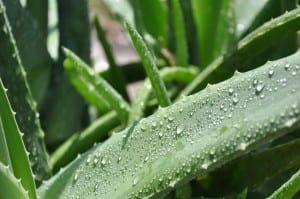Aloe Vera is not a difficult plant to care for. It does grow faster outdoors during warmer months, but it doesn’t mind a pot and does just fine in the house. Some basic things to watch out for: it’s true that Aloe’s like sun, but they can turn brown in harsh light. Indirect is best. Also, they can freeze during the winter and should be protected from frost. Move your Aloes indoors during cold months if you can.
Watering Your Aloe

When it comes to watering, an Aloe Vera plant is in greater danger of being overwatered than underwatered. Aloes like a soil that drains well. A cactus mix or a sandy soil is good for larger pots. Smaller pots drain quickly, and any good potting soil will do the trick. Water your Aloe sparingly in the winter since it won’t be drying up very fast. It won’t need to be watered very often, maybe once a ever week or two. In the summertime you can really soak the soil, but let the soil dry out between waterings. Make sure there is a drainage hole in the pot since the roots are prone to rot when exposed to long periods of wet soil.
Down and Dirty
The best way to check the soil is to get about 2-3 inches into the soil. If your Aloe Vera plant is small you only need to check about 1-2 inches in. It is very common for some parts to be dryer than others so make sure you check close to the base of the plant. The roots of Aloe aren’t that long, so the dirt close to the base of the plant should not be moist. By moist, I mean soil that sticks to your fingers. Let the soil get to the point where it is crumbly and lighter in color. Let it stay that way for a few days before watering the plant again.
Reading Aloe leaves
Poor Aloe Vera plant care shows in the leaves. Here’s how you can tell what is happening with your plant:
- Aloe leaves should grow upward, away from the base of the plant. If the leaves are lying flat, your Aloe probably has insufficient light. Although it will turn brown with too much
 light, it still needs a good amount of sunshine.
light, it still needs a good amount of sunshine. - If the leaves are thin and curled, you probably are not watering your Aloe enough. The plant is using up its own liquid to keep itself nourished. Give it some water!
- When the leaves are brown, as I mentioned before, your plant should be taken to a place with less direct sunshine.
- If the plant is growing very slowly, the soil or water might be too alkaline. It could also mean that the plant was too damp for too long, needs more light, or has too much fertilizer. It might also like a bigger pot.
Repotting
Repotting an Aloe Vera plant is not necessary until the upper plant gets too top-heavy. The plant can stand to be root-bound, which means the roots become tangled and grow in circles. When it does become root-bound it will send up more shoots, or pups. More Aloe for you! If these little Aloes are not removed and replanted, they will suck the life out of the mother plant- parenting is tough. Some signs that this is happening include a bright green color in the parent horizontally growing leaves. When repotting Aloe pups, give them a good watering in their new pot, and then don’t water them again for 3 weeks. This will force the new roots to seek water. It is normal for the transplanted plant to turn grey or brown for a while. They are in shock. Keeping them in a shady spot during this period will help them to bounce back faster. For step by step instructions on repotting, check out this article.
No comments:
Post a Comment